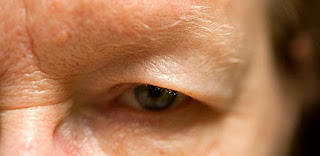Dermatochalasis Images, Definition, Symptoms, Causes, Surgery
Baggy eyes is another name of dermatochalasis. In this condition there is excess skin around eyes I.e. upper and lower eye lid. It is common in elder patients and adults. It occurs due to loss of elasticity in skin tissues around eyes. The connective tissue around eyes becomes weak. Frequently the upper eye lid is involved but lower eye lid are also common in dermatochalasis. Dermatochalasis is a cosmetic or functional problem. If the dermatochalasis is functional problem, then it affects superior visual field. Other than this, patient experience ocular irritation, entropion of lower eyelid and entropion of upper eye lid.
Dermatochalasis is also known as baggy eyes. It is common in old age patients and adults. If it is a cosmetic problem then patient does not have to worry, some of the home remedies can fix it but if it is a functional problem then vision can be affected. And for that, proper treatment I.e. Surgery is required. In below picture, the loose skin around eyes is prominent and looks like falling downwards. Due to dermatochalasis, patient looks old before age.

Heavy eyelids is the commonest symptom of dermatochalasis. Symptoms associated with cosmetic problem of dermatochalasis include puffy eyes, loose skin around eyes, inflammation around eyes, patient can't see properly because of loose upper eyelid covering eyes. Functional problem of dermatochalasis, patient face vision problems like problem in superior vision field, loss of peripheral vision while driving and patient also feels difficulty in reading newspaper and books. Patients with mild to severe dermatochalasis, lift up their eye brows to improve their visual field. And this lifting up of eye brows causes headaches. Other symptoms include dry eyes and ocular irritation.
There are different causes reported behind dermatochalasis. Some of the common causes are as follows:
Dermatochalasis can be treated with medications if it is mild. But in case of chronic dermatochalasis, surgery is recommended. In surgery, a crease is marked in the upper eyelid and then pinch technique is used to lift eyelid. The eyelid should be lift up in a right amount that the eye does not open upon lifting eyelid. Many measurements are made to maintain symmetry. Lidocaine or epinephrine are used to make it numb locally. Then incision is made according to the crease line. The cut of upper eyelid should not be less than 7 to 8 mm from eyebrow. A blade, laser or radio frequency device is used to excise skin.
Dermatochalasis Images
Dermatochalasis is also known as baggy eyes. It is common in old age patients and adults. If it is a cosmetic problem then patient does not have to worry, some of the home remedies can fix it but if it is a functional problem then vision can be affected. And for that, proper treatment I.e. Surgery is required. In below picture, the loose skin around eyes is prominent and looks like falling downwards. Due to dermatochalasis, patient looks old before age.

Dermatochalasis Symptoms
Heavy eyelids is the commonest symptom of dermatochalasis. Symptoms associated with cosmetic problem of dermatochalasis include puffy eyes, loose skin around eyes, inflammation around eyes, patient can't see properly because of loose upper eyelid covering eyes. Functional problem of dermatochalasis, patient face vision problems like problem in superior vision field, loss of peripheral vision while driving and patient also feels difficulty in reading newspaper and books. Patients with mild to severe dermatochalasis, lift up their eye brows to improve their visual field. And this lifting up of eye brows causes headaches. Other symptoms include dry eyes and ocular irritation.
Dermatochalasis Causes
There are different causes reported behind dermatochalasis. Some of the common causes are as follows:
- It may occur secondary to trauma.
- Severe periorbital edema is also responsible for causing dermatochalasis. If the inflammation of eyelid remains for longer duration, it becomes chronic and then it may lead to recurrent edema.
- Thyroid eye disease is associated with dermatochalasis. In this, the infiltration of orbital fat occurs along with extra occular muscles with immunoglobulins complexes.
- Chronic renal insufficiency, amyloidosis and floppy eye syndrome are the rare causes of dermatochalasis.
- Last but not least, blepharospasm is also responsible for dermatochalasis.
Dermatochalasis Surgery
Dermatochalasis can be treated with medications if it is mild. But in case of chronic dermatochalasis, surgery is recommended. In surgery, a crease is marked in the upper eyelid and then pinch technique is used to lift eyelid. The eyelid should be lift up in a right amount that the eye does not open upon lifting eyelid. Many measurements are made to maintain symmetry. Lidocaine or epinephrine are used to make it numb locally. Then incision is made according to the crease line. The cut of upper eyelid should not be less than 7 to 8 mm from eyebrow. A blade, laser or radio frequency device is used to excise skin.
Dermatochalasis Images, Definition, Symptoms, Causes, Surgery
 Reviewed by Simon Albert
on
April 05, 2019
Rating:
Reviewed by Simon Albert
on
April 05, 2019
Rating:
 Reviewed by Simon Albert
on
April 05, 2019
Rating:
Reviewed by Simon Albert
on
April 05, 2019
Rating:











